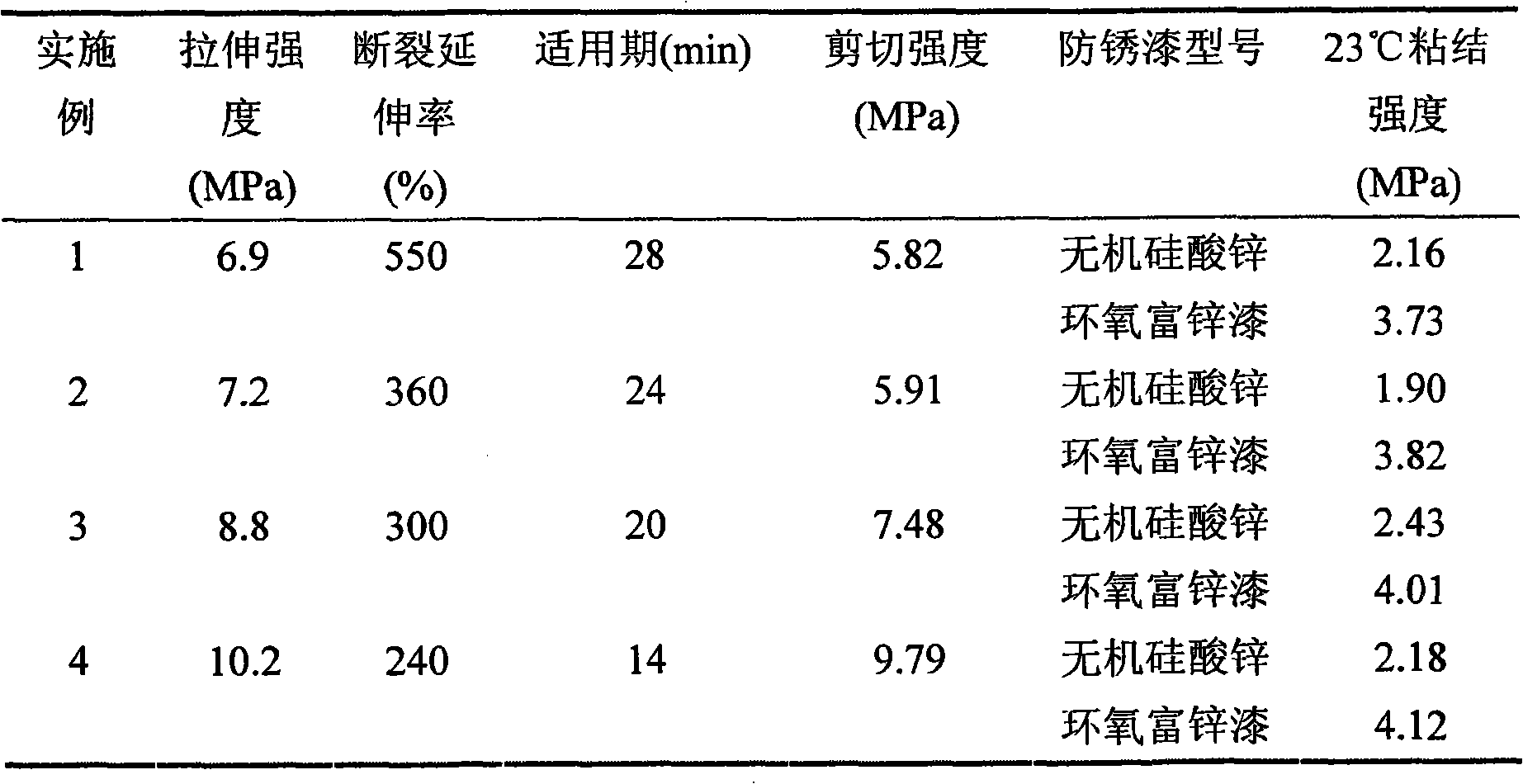Epoxy asphalt material for road-bridge and environment-friendly preparation method thereof
An epoxy asphalt material, road and bridge technology, applied in building insulation materials, roads, roads, etc., can solve the problems of methacrylic acid volatilization and sublimation, and achieve environmental friendliness, good flexibility, and excellent fatigue resistance Effect
- Summary
- Abstract
- Description
- Claims
- Application Information
AI Technical Summary
Problems solved by technology
Method used
Image
Examples
Embodiment 1
[0044] Example 1: Add 57 parts (mass, the same below) of petroleum asphalt (origin: Shanjiasi) heated to 90-120°C into the reactor, add 1.14 parts of maleic anhydride, heat up to 120-155°C, and wait for the pressure to stabilize , into N 2 , keep the total pressure at 0.25MPa, and after 4 hours of reaction, slowly release the pressure to 0.1MPa. Then gradually lower the temperature to 100-110°C, add 10 parts of polyethylene glycol (DC-4110, Ningwu Chemical Plant, Jurong City, Jiangsu Province; calculated based on the neutralization of completely residual functionalized asphalt modified small molecular compounds parts by mass; the same below), 1.2 parts of liquid hydroxyl-terminated polysiloxane (107 silicone rubber, 3000 cP, Shanghai Silicon Mountain Polymer Material Co., Ltd.), and then the temperature was programmed to 130-140 ° C for 1-3 hours. Then add 17.16 parts of oxalic acid, 5 parts of polyisobutylene succinic anhydride (average molecular weight: 5100, Changzhou Guan...
Embodiment 2
[0045] Example 2: Add 57.3 parts of petroleum asphalt (US Shell) heated to 90-120 ° C into the reactor, add 11.4 parts of maleic anhydride, heat up to 120-160 ° C, and after the pressure is stable, feed N 2 , keep the total pressure at 0.45MPa, and after 5 hours of reaction, slowly release the pressure to 0.1MPa. Then gradually lower the temperature to 100-110° C., add 2 parts of polypropylene glycol (DC-403, Ningwu Chemical Factory, Jurong City, Jiangsu Province), and program the temperature to 130-140° C. to react for 1-3 hours. Then add 15.13 parts of dimer acid (Zhejiang Yongzai Chemical Factory), 10 parts of adipic acid, 3 parts of polyisobutylene succinic anhydride (average molecular weight 2400, Changzhou Guanghui High-tech Chemical Co., Ltd.) that have been heated to 90-140 ° C in advance, 10 parts of polyazelaic anhydride (average molecular weight 1200, Changzhou Guanghui High-tech Chemical Co., Ltd.) and 0.57 parts of triethylamine were pre-mixed for 30 minutes and d...
Embodiment 3
[0046] Example 3: Add 68 parts of petroleum asphalt (US Shell) heated to 90-140°C into the reactor, add 8.2 parts of maleic anhydride, heat up to 230°C for reaction, and reflux with 80°C warm water at the same time, after reacting for 6 hours, then gradually Cool down to 100-110°C, add 3.2 parts of liquid hydroxyl-terminated polysiloxane (107 silicone rubber, 3000cP, Shanghai Silicon Mountain Polymer Material Co., Ltd.), program temperature rise to 130-140°C and react for 1-3 hours. Alkyd resin (brand 3370A, Jiangsu Sanmu Group Co., Ltd.) 14.4 parts, methyl nadic anhydride (Changzhou Guanghui High-Tech Chemical Co., Ltd.) 5 parts, polyglutaric anhydride (average molecular weight 1200, Changzhou Guanghui High-Tech Chemical Co., Ltd.) ) 7 parts, and 0.6 parts of diethylenetriamine were added to the reactor, stirred and mixed for 1 hour, and finally dispersed at high speed in the colloid mill to obtain part A; when in use, part A and part B (epoxy resin E -44) Raise the temperatu...
PUM
 Login to View More
Login to View More Abstract
Description
Claims
Application Information
 Login to View More
Login to View More - Generate Ideas
- Intellectual Property
- Life Sciences
- Materials
- Tech Scout
- Unparalleled Data Quality
- Higher Quality Content
- 60% Fewer Hallucinations
Browse by: Latest US Patents, China's latest patents, Technical Efficacy Thesaurus, Application Domain, Technology Topic, Popular Technical Reports.
© 2025 PatSnap. All rights reserved.Legal|Privacy policy|Modern Slavery Act Transparency Statement|Sitemap|About US| Contact US: help@patsnap.com



